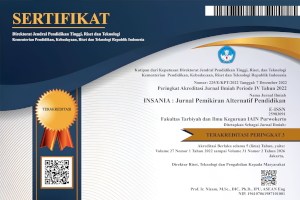SEKOLAH ALAM: EVALUASI PROGRAM SEKOLAH DALAM MENUMBUHKAN KECERDASAN NATURALISTIK DAN KINESTETIK PADA PENDIDIKAN ANAK USIA DINI
DOI:
https://doi.org/10.24090/insania.v25i1.3542Keywords:
Sekolah Alam; Program Evaluation; Naturalist Intelligence; and Kinesthetic IntelligenceAbstract
Naturalist and kinestetic Intelligence in Early childhood become the main parameters in the stages of growth and development. This Intelligence becomes a strong foundation in the future in achieving self-success in the industrial era 4.0. In guarding the growth and development of early childhood, Sekolah Alam was an solutions to prpare for the golden generation in the future. Program evaluation carried out with the CIPP (Context Input Process Poduct) model approach aim to measures the achievement of the implementation of the organizing and outcome program for the students. The result showed that the implementation of the program was in the very good category 88,9% and outcome 87,5% student achievied the curriculum target, so it can be concluded that the Sekolah Alam curriculum was succesfully implemented to build the naturalist and kinesthetic intelligence.Downloads
References
Daniati, S. P. (2019). Natural School Culture as a Free And Fun Alternative Education in Building the Students’ Character. Elementary Education Online, 18(1). https://doi.org/10.17051/ilkonline.2019.527617
Davis, K., Christodoulou, J., Seider, S., & Gardner, H. (2010). The Theory of Multiple Intelligences. 37.
Diamantopoulos, A. (1994). Modelling with LISREL: A guide for the uninitiated. Journal of Marketing Management, 10(1–3), 105–136. https://doi.org/10.1080/0267257X.1994.9964263
Fitriani, R. (2018). Perkembangan Fisik Motorik Anak Usia Dini. 3(1), 10.
Gardner, H. (2011). Frame of Mind: The Theory of Multiple Intelligences (3rd Edition). A Member of the Perseus Books Group, New York.
Hasanah, U. (2016). Pengembangan Kemampuan Fisik Motorik Melalui Permainan Tradisional Bagi Anak Usia Dini. Jurnal Pendidikan Anak, 5, 717–733.
Hashim, H. H., & Denan, Z. (2015). Importance of Preserving the Natural Environment in the Design Schools in Malaysia. Procedia - Social and Behavioral Sciences, 170, 177–186. https://doi.org/10.1016/j.sbspro.2015.01.027
Joreskog, K. G. (1993). Lisrel 8: Structural Equation Modeling with the SIMPLIS Command Language. Scientific Software International, Inc.
Spalie, N., Utaberta, Abdullah, Tahir, M., & Ani, C. (2011). Reconstructing Sustainable Outdoor Learning Environment in Malaysia from the Understanding of Natural School Design and Approaches in Indonesia. Procedia - Social and Behavioral Sciences, 15, 3310–3315. https://doi.org/10.1016/j.sbspro.2011.04.291
Stufflebeam, D. L. (2002). Evaluation Models (Second Edition). Kluwer Academic Publishers. http://kluweronline.com
Taylor, A. F., & Kuo, F. E. (2006). Is contact with nature important for healthy child development? State of the evidence. Dalam C. Spencer & M. Blades (Ed.), Children and their Environments (hlm. 124–140). Cambridge University Press. https://doi.org/10.1017/CBO9780511521232.009
Widaningsih, T., Widyawati, P. N., Shodiq, A., & Zayadi, A. (2019). Revolusi Industri 4.0 Dan Pendidikan Aanak Usia Dini Untuk Generasi ALFA: Sebuah Telaah. 2, 9.
Yuningsih, R. (2015). Peningkatan Kecerdasan Kinestetik Melalui Pembelejaran Gerak Dasar Tari Minang. 9, 18.
Downloads
Published
How to Cite
Issue
Section
License
Authors who publish with this journal agree to the following terms:
Authors retain copyright and grant the journal right of first publication with the work simultaneously licensed under a Creative CommonsAttribution-ShareAlike License that allows others to share the work with an acknowledgment of the work's authorship and initial publication in this journal.
Authors are able to enter into separate, additional contractual arrangements for the non-exclusive distribution of the journal's published version of the work (e.g., post it to an institutional repository or publish it in a book), with an acknowledgment of its initial publication in this journal.
Authors are permitted and encouraged to post their work online (e.g., in institutional repositories or on their website) prior to and during the submission process, as it can lead to productive exchanges, as well as earlier and greater citation of published work (See The Effect of Open Access).








